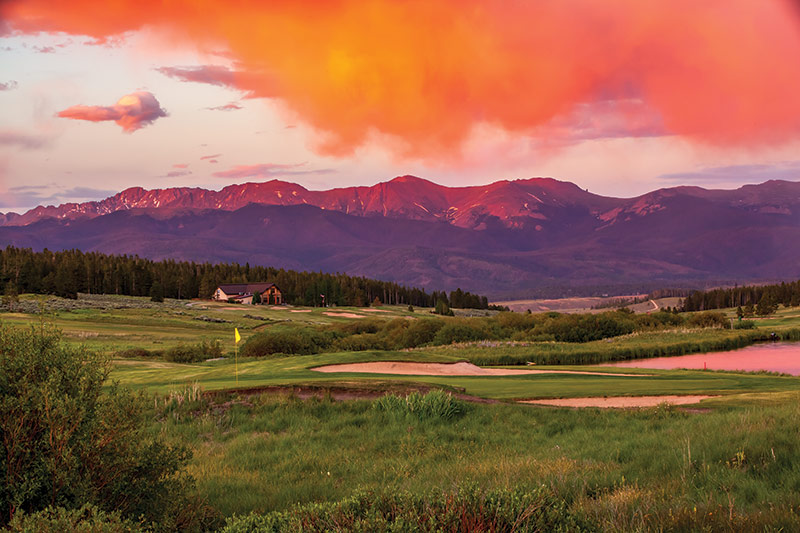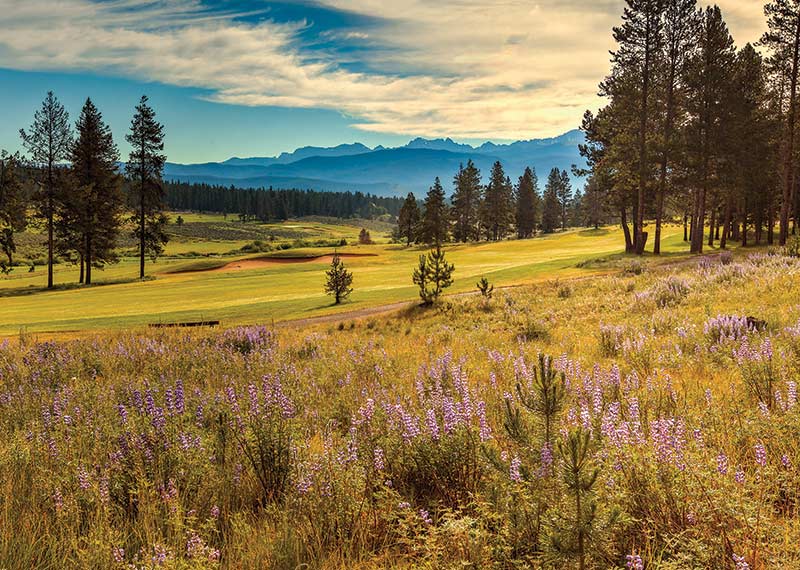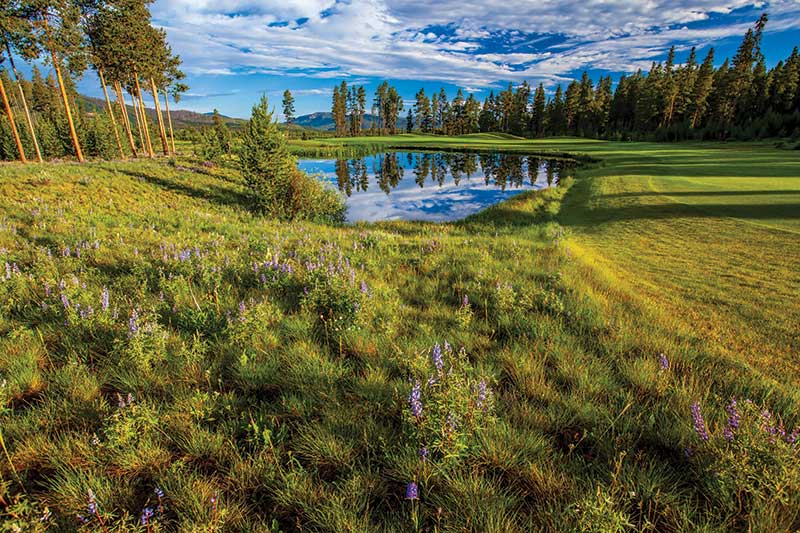CSU Grad Davis Bryant Discusses His Rise as a Pro Golfer
Colorado State grad Davis Bryant opens up on his path to the pros and what keeps him busy when he’s off the course

IT BEGAN WITH a dream as grand as the mountain peaks that tower over Winter Park. In the 1970s, a Grand County native named Wendell Ley donated a spectacular tract of land along Pole Creek to the Fraser Valley Metropolitan Recreational District. Local businessmen envisioned a golf course that would be a summertime counterpart to Winter Park Ski Resort. “Back then, there wasn’t a lot going on here in the summer,” says Mary Moynihan, Pole Creek’s Clubhouse Manager.
The Fraser Rec District went big, hiring the esteemed design firm of Kirby, Player and Associates (yes, golf legend Gary Player). The architect assigned to create the new course outside of Winter Park was a rising star named Denis Griffiths. “During our first trip in 1979, we looked at 3–4 potential sites,” said Griffiths. “As soon as we walked the (Pole Creek) land, you realized it was the perfect place for a golf course.”
The future Pole Creek Golf Course had been a working ranch since 1895. “What is today The Meadow Course was an open area where they grew hay,” remembers Moynihan. “The Ranch Course is where the old ranch structures were located.”

Bisecting the land was the meandering Pole Creek. In the distance were majestic James and Parry Peaks, along with Devil’s Thumb. “The east/ west orientation of the valley certainly identified the course focal point: the Continental Divide,” recalls Griffiths. “Having the ability to take the holes back and forth is part of what made the site so good.”
Griffiths and his team approached the Pole Creek job with the idea of honoring the land’s ranching heritage while embracing its natural beauty. “First time I saw that land, you could see the golf holes—they came right out,” said Mike Kosak, Pole Creek’s first Superintendent.
But building a golf course at 8,600 feet came with a mountain of challenges. The growing season is just 100 days. And then there’s the weather. “The year we planted seed, there were just 11 days without frost,” remembers Kosak. “You can only imagine the challenge of growing Kentucky Bluegrass high in the Colorado Rockies.” Four ponds were created for water storage. Only a few trees had to be cut. Today’s Ranch No. 3 was the first hole to be built and the other 17 soon followed. Griffiths and Kosak were determined to use a light touch. “Our job was to enhance the beauty of what was there,” said Griffiths. “That was our ultimate goal.”

Eighteen holes of mountain golf, dubbed The Meadow (front 9) and The Ranch (back 9), opened in 1985. It did not take long for the golf world to notice. Golf Digest honored Pole Creek Golf Club as the best new course in America in 1985. Thirty-five years later, the accolades con- tinue. For the fourth consecutive year, Pole Creek has been honored with the CAGGY Award for Colorado’s best mountain course. Course Pro J.T. Thompson says: “Even if you are not at the top of your game, you still have the magnificent views. It’s like a walk in the park.”
Denis Griffiths went on to design courses around the globe, including St. Andrew’s Bay in Scotland. He has collaborated with Snead, Sarazen, Trevino and other legends. But Colorado remained close to his heart. The Griffiths-designed Fox Hollow Golf Course opened in Lakewood in 1993. The Homestead at Fox Hollow, another Griffiths course, opened nine years later.
The Ridge, a 9-hole tract that overlooks the Pole Creek, opened in 2000. The Ridge is a golf- er’s climb through a forest of towering lodgepole pines. It is at once a heart-pumping and cerebral experience—punctuated with breathtaking views. “We wanted to create something very different from The Ranch and The Meadow,” said designer Denis Griffith. “We want to create diversity without making The Ridge a totally different course.”

Construction of The Ridge began in 1997. “When we started building the course, every hole—with the exception of number 5—was completely covered with trees,” says Larry Burks, who was Pole Creek’s Superintendent at the time. Griffiths charted the 9-hole layout by studying contours from a topographic map. After hundreds of hikes through the dense forest, Griffiths began to see a beautiful course. “We would clear a 40– 50-foot corridor that gives you a slot you could see through,” said Griffiths. “That helps give you the view of how the land lays out.” Next came the daunting task of carving a golf course out of the thick alpine forest. Once the course was roughed out, water had to be pumped up from Pole Creek, a mile and a half uphill journey. Three interconnected holding ponds were created to feed water to the fairways and greens of The Ridge. Equally important was grading the land to keep the water moving off the ridge and into the valley. “The three most important words in golf are: drainage, drainage, and drainage,” says Superintendent Burks.
Each hole of The Ridge is isolated from the others, shielded by the towering pines. Every July, the forest floors are carpeted with spectacular displays of lupine. Today, it is Pole Creek’s most popular course. “There is a reason every- one wants to play The Ridge: the trees and the seclusion,” says Burks. Griffiths wants it to be more than about golf. “It’s like: I am in the middle of nowhere. I love this,” says the designer. “The farther from the clubhouse, the more you feel like you are in the wilderness.” And there’s also the views. The Ridge’s signature hole is No. 9, a 556-yard downhill Par-5 that begins 140 feet above the Pole Creek Valley. Many consider it among the best finishing holes in Colorado golf. “The drama of standing on the ninth tee is unparalleled,” says Griffiths. “It’s a real ‘Whoa Nelly.’”

Today, The Ridge completes the puzzle of Pole Creek’s three courses—a 27-hole trinity of mountain golf. “It is a place where you can feel isolated in the beauty of the landscape,” says Burks. The Ridge also fulfills the dreams of residents who dreamt of world class golf near Winter Park. Pole Creek’s first superintendent, Mike Kosak, sums up the feelings of all who created this sculpture of Colorado golf: “On that property, golf was meant to be played.”
Chris Wheeler is an avid golfer who was been creating documentary films for more than three decades. Many of his award-winning works tell the stories of our National Parks.
This article was also featured in the May Issue of Colorado AvidGolfer.
Colorado AvidGolfer is the state’s leading resource for golf and the lifestyle that surrounds it, publishing eight issues annually and proudly delivering daily content via coloradoavidgolfer.com.
Colorado State grad Davis Bryant opens up on his path to the pros and what keeps him busy when he’s off the course
The staff at Dream Makers Landscape is ready to help you enhance the look and feel of your property with our exceptional landscaping projects